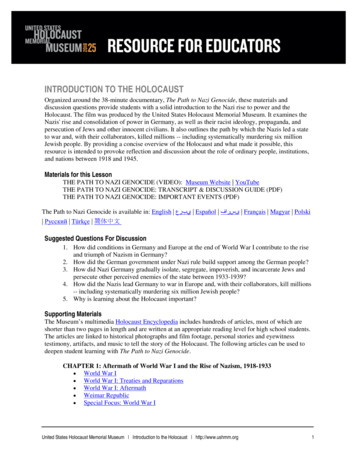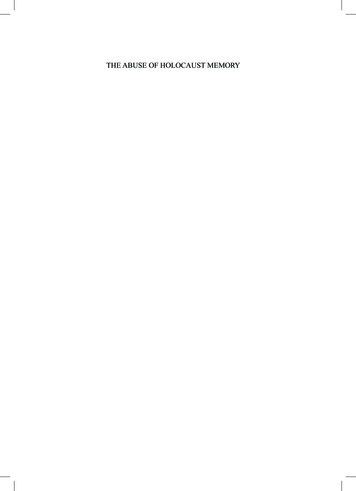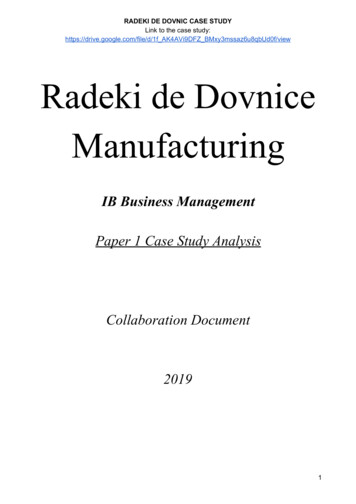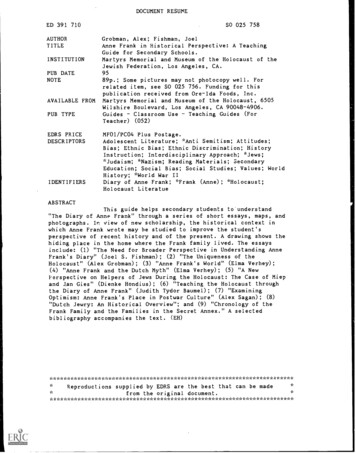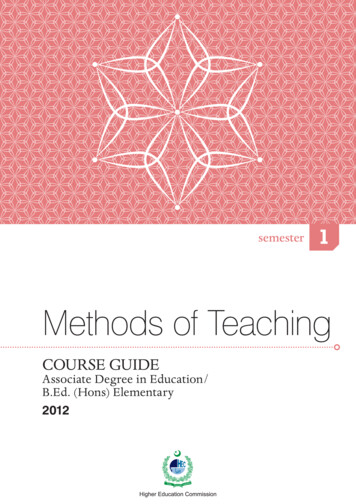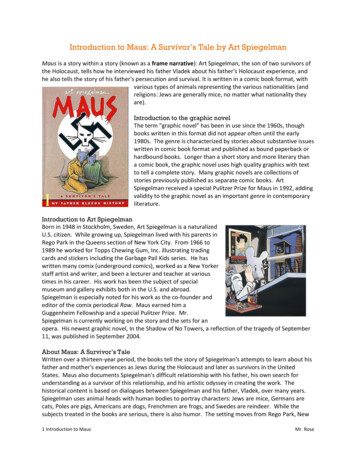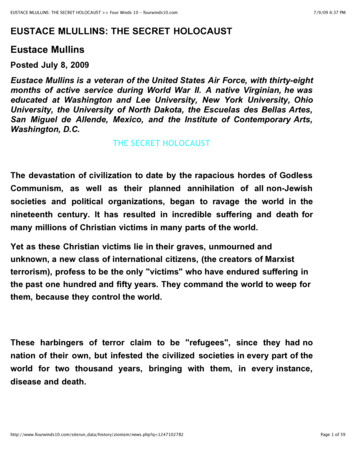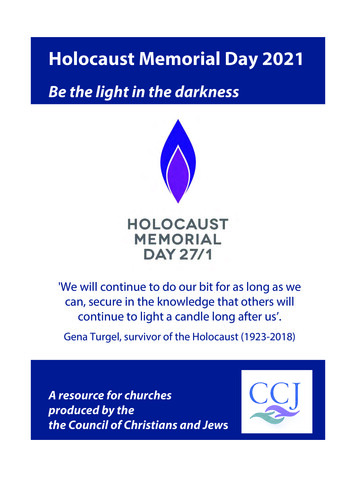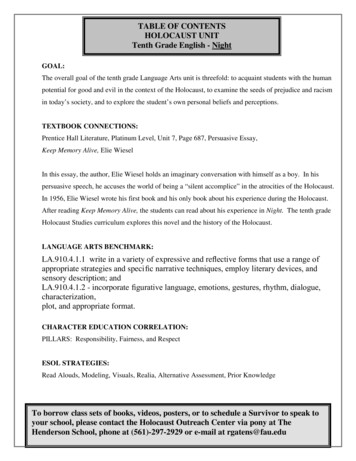
Transcription
TABLE OF CONTENTSHOLOCAUST UNITTenth Grade English - NightGOAL:The overall goal of the tenth grade Language Arts unit is threefold: to acquaint students with the humanpotential for good and evil in the context of the Holocaust, to examine the seeds of prejudice and racismin today’s society, and to explore the student’s own personal beliefs and perceptions.TEXTBOOK CONNECTIONS:Prentice Hall Literature, Platinum Level, Unit 7, Page 687, Persuasive Essay,Keep Memory Alive, Elie WieselIn this essay, the author, Elie Wiesel holds an imaginary conversation with himself as a boy. In hispersuasive speech, he accuses the world of being a “silent accomplice” in the atrocities of the Holocaust.In 1956, Elie Wiesel wrote his first book and his only book about his experience during the Holocaust.After reading Keep Memory Alive, the students can read about his experience in Night. The tenth gradeHolocaust Studies curriculum explores this novel and the history of the Holocaust.LANGUAGE ARTS BENCHMARK:LA.910.4.1.1 write in a variety of expressive and reflective forms that use a range ofappropriate strategies and speci fic narrative techniques, employ literary devices, andsensory description; andLA.910.4.1.2 - incorporate figurative language, emotions, gestures, rhythm, dialogue,characterization,plot, and appropriate format.CHARACTER EDUCATION CORRELATION:PILLARS: Responsibility, Fairness, and RespectESOL STRATEGIES:Read Alouds, Modeling, Visuals, Realia, Alternative Assessment, Prior KnowledgeTo borrow class sets of books, videos, posters, or to schedule a Survivor to speak toyour school, please contact the Holocaust Outreach Center via pony at TheHenderson School, phone at (561)-297-2929 or e-mail at rgatens@fau.edu
TENTH GRADE ENGLISH CURRICULUM - NightTABLE OF CONTENTSHOLOCAUST STUDIES CURRICULUMTENTH GRADE ENGLISH - NIGHTNovelNight, by Elie WieselActivity OneKWL Chart and Identification of Scapegoats . . . . . . . . . . . . . . . . . . . .3Activity TwoExamine Racism and Historical Background of Novel . . . . . . . . . . . . .6Activity ThreeIntroduce Night – Read and Discuss Pgs 1-14 . . . . . . . . . . . . . . . . . . . .9Activity FourNight – Irony, Foreshadowing, and Discussion Pgs 15-26 – Quiz 1. . .14Activity FiveNight – Discuss Pages 27-43 . . . . . . . . . . . . . . . . . . . . . . . . . . . . . . . . .20Activity SixNight – Continue Pages 27-43 and Dehumanization Tactics . . . . . . . .22Activity SevenNight – Discuss Pages 45-62 - Quiz 2 . . . . . . . . . . . . . . . . . . . . . . . . . .25Activity EightNight – Discuss 63-80 . . . . . . . . . . . . . . . . . . . . . . . . . . . . . . . . . . . . . .30Activity NineNight – Discuss 81-92 . . . . . . . . . . . . . . . . . . . . . . . . . . . . . . . . . . . . . .32Activity TenNight – Discuss Conclusion of Novel . . . . . . . . . . . . . . . . . . . . . . . . .34Activity ElevenNight – Technique and Purpose of Novel - Final Test/Essay . . . . . .39Activity TwelveNight – Meet a Survivor46.To borrow class sets of books, videos, posters, or to schedule a Survivor to speak toyour school, please contact the Holocaust Outreach Center via pony at TheHenderson School, phone at (561)-297-2929 or e-mail at rgatens@fau.eduDepartment of Multicultural Education, 2004, The School District of Palm Beach County, FloridaAll Rights ReservedHolocaust Studies Curriculum2
TENTH GRADE ENGLISH CURRICULUM - NightACTIVITY ONEObjectives To understand the reasons for prejudice. To identify groups used as scapegoats.Materials Wiesel, E. Night. New York. Bantam Books. 1960. KWL Chart and Map OverheadHomework For the duration of this unit, students should keep a journal. Decide whether journals will be used forhomework or classwork. Students will be expected to reflect about class discussions, readings, andreactions to materials in addition to assigned journal topics. The teacher might prefer to have studentswrite in their journal for the last five minutes of each class. Students should be instructed to date eachentry and to number each page. The entry may be both a visual and/or a written document. A studentmay respond to the day’s lesson, relate a personal experience, and/or include poetry, prose, or art. Theteacher should always read and respond to journals on a regular basis. Journal Entry: Tell about any other story about the Holocaust you have seen, heard, or read about.Summarize his/her particular story.Activities1. Elicit the meaning of the word PREJUDICE, listing several responses on the board. Explain that avery simple way to think of it is by dividing the word into its two components, PRE and JUDGE. Askstudents the basis on which prejudging is usually made. An expected reply might include: emotion,rumor, or feelings. Tell students that prejudice is not based on fact or reason.2. Explain that the prejudice against Jews, which will be explored in this book, is not unique. Quite earlyin history groups have viewed others through a closed mind or judged them negatively withoutDepartment of Multicultural Education, 2004, The School District of Palm Beach County, FloridaAll Rights ReservedHolocaust Studies Curriculum3
TENTH GRADE ENGLISH CURRICULUM - Nightknowing any member of the group on a personal basis. This is a human failing; one often makesemotional judgments, not rational ones. Ask students to explain if they have ever mistakenly viewedsomeone because of what he or she looked liked, or saw someone else do so.3. Explain to students since prejudice is learned from one’s parents, siblings, relatives, peers, and theculture in which one lives, it can be stopped and changed. When one learns of these prejudices, onebrands people as having certain characteristics whether one does or not. Have students speculateabout the reasons for negative stereotypes such as one’s own inferiority, economic fears.4. A teacher should show a portion of a video that deals with prejudice. Recommended videos include:A Shadow Between Friends, The Prejudice Film, Prejudice: The Monster Within.5. Use the KWL chart (page 5) on the overhead to elicit what students already know about World War IIand the Holocaust. Include the prejudices people had for others around the time of the war. Remindstudents that this period was before the civil rights movement. Work with the World History teacherand combine efforts to ensure full understanding of the background and setting of the novel.Department of Multicultural Education, 2004, The School District of Palm Beach County, FloridaAll Rights ReservedHolocaust Studies Curriculum4
TENTH GRADE ENGLISH CURRICULUM - NightKWhat We KnowWWhat We Want to LearnDepartment of Multicultural Education, 2004, The School District of Palm Beach County, FloridaAll Rights ReservedLWhat We LearnedHolocaust Studies Curriculum5
TENTH GRADE ENGLISH CURRICULUM - NightACTIVITY TWOObjectives To explain racism, antisemitism, genocide, and the Holocaust. To perceive the historic background of WWII and the Holocaust. To learn about Elie Wiesel.Materials Selected Videos: The Twisted Cross, Genocide, The Master Race, Our CenturyHomework Journal Entry: Reflect on a way you have seen someone combat prejudiced behavior. If you havenever experienced this, think what you would do in a situation where someone is being emotionallyor physically persecuted because of color, race, sex, handicap, sexual preference or religion. Students will read the biographical sketch of Elie Wiesel and will read the Forward to Night.Activities1. Place the word RACISM on the board and define it as the hatred of all members of a particularrace or ethnic group. It is an extreme, often violent, form of prejudice that disregards theindividual qualities of the members of the hated group. Elicit current examples of racism.2. EXTRA CREDIT: The teacher might offer excerpts from novels presenting examples of racismsuch as: Black Boy, by Richard Wright, Forty Days at Musa Dagh, by Franz Werfel, or To Kill aMockingbird, by Harper Lee. (Small groups might be assigned to read an excerpt for extra creditand discuss the limitations placed on the protagonists through racism.)3. The teacher should define ANTISEMITISM as hatred of a person of Jewish origin. Remindstudents that antisemitism began 2000 years ago, not just with the rise of the Nazi party.4. Write the term GENOCIDE on the board. Explain that genocide was a term created after WorldWar II as a result of how Jews and other ethnic groups were mistreated during the war.Department of Multicultural Education, 2004, The School District of Palm Beach County, FloridaAll Rights ReservedHolocaust Studies Curriculum6
TENTH GRADE ENGLISH CURRICULUM - Night5. Using a dictionary, have one student look up the derivation of the word genocide. Its root is theGreek GENOS, meaning race, tribe or nation. The Latin suffix CIDE means killing. Explain thatthe intent of genocide is the total annihilation of a race or ethnic group. Genocide results fromprejudice being taken to an extreme degree.6. Place the word HOLOCAUST on the board, and follow the same procedure. Its Greek rootmeans burnt whole.7. Ask students if they would like to share their previous journal entry about what books, movies, ortelevision shows they have seen dealing with the Holocaust.8. Discuss wars throughout history and the lives that are lost in war. Elicit from students how manydifferent wars they can think of in the 20th century. Ask why some of these wars occurred.9. Show a video as an introduction that depicts the Holocaust in its historic context. Recommendedchoices include: The Twisted Cross, Genocide, The Master Race, or Our Century. Videos are onloan through the Holocaust Outreach Center at FAU (561)297-2929.10. Ask why the Holocaust is considered a watershed event in human history.11. Students should be asked to record their reactions to the video in their journals.12. Have the students read the biography on Elie Wiesel (page 8). If you have Internet access, askstudents to look only at the following sites to derive their own short report on Elie’s achievements.Department of Multicultural Education, 2004, The School District of Palm Beach County, FloridaAll Rights ReservedHolocaust Studies Curriculum7
TENTH GRADE ENGLISH CURRICULUM - NightElie WieselRomanianNobel Prize recipient/author 1986Ellis Island Medal of Honor recipient 1992Born in the town of Sighet in northern Transylvania, near the Ukrainian border in 1928, Eliezer Wieselgrew up experiencing first-hand the horrors of the Holocaust.In 1944, Wiesel and his family were transported to Auschwitz concentration camp in Poland duringWorld War II. There, Elie's mother and youngest sister, Tzipora, died in the gas chambers. Thefollowing year, after he and his father were transferred to Buchenwald, the senior Wiesel died fromstarvation and dysentery. Elie did not learn that his two older sisters were alive until after the war.In 1945, at the end of the war, Wiesel moved to Paris, where he studied literature, philosophy, andpsychology at the Sorbonne. With a strong desire to write, Mr. Wiesel worked as a journalist in Parisbefore coming to the United States in 1956. He became an American citizen almost by accident. Aftercoming to New York City on assignment, he was hit by a taxicab and confined to a wheelchair for ayear. A friend convinced him to apply for U.S. citizenship, and he eventually decided to remain inAmerica.Credited by many as being the first person to use the term "Holocaust," Mr. Wiesel published his firstnovel in 1956. Un di Velt Hot Geshvign (And the World Has Remained Silent) was the first of a seriesof books Wiesel would write about his experiences at Auschwitz and Buchenwald. Although his workswere ultimately successful, Elie Wiesel met with initial skepticism. "The Holocaust was not somethingpeople wanted to know about in those days," he reported in an interview with Time magazine. "TheDiary of Anne Frank was about as far as anyone wanted to venture into the dark."Elie Wiesel also worked for the improved treatment of Jews in the Soviet Union. His book, The Jews ofSilence: A Personal Report on Soviet Jewry, helped to make the world aware of the plight of Jewishpeople attempting to survive in the Soviet Union. He has been seen by many as a pioneer in theliberation of Soviet Jews.Mr. Wiesel's goal in his writings has primarily been to educate others on the plight of Jews around theworld. Through the relating of his own experiences, he hopes to make people aware of the injusticegoing on around them, therefore preventing what happened during World War II from occurring again.In 1986, Elie Wiesel was awarded the Nobel Peace Prize for his efforts in improving the livingconditions, and promoting the understanding and global acceptance of Jews. For this same reason, Mr.Wiesel was presented with an Ellis Island Medal of Honor in 1992.With permission from: lOther websites which include biographical information:http://home.sn.no/ /27498.htmhttp://www.bkstore.com/bu/fac/wiesel bio.htmlDepartment of Multicultural Education, 2004, The School District of Palm Beach County, FloridaAll Rights ReservedHolocaust Studies Curriculum8
TENTH GRADE ENGLISH CURRICULUM - NightACTIVITY THREEObjectives To introduce the people in the memoir. To analyze how the persecuted slowly lost their freedoms.Materials Wiesel, E. Night. New York. Bantam Books. 1960. Overheads: “Background Information on Novel,” “Jews Gradually Lost Their Freedoms,” and“Jewish Vocabulary Used in Novel.”Homework Journal Entry: Write about how you would get news, happenings around your city, state andcountry, weather, and other information if there were no TV news, radio, or computer available.Would you ask other people? What would you believe/trust? Read pages 21-26.Activities1. Compare and contrast the differences between fiction and non-fiction books and then compare thedifferences between a novel and a memoir. Use a Venn diagram (page 14). Possible areas ofcomparison/contrast for Fiction/Non-Fiction: purpose, concepts, characters, settings. Possibleareas of comparison/contrast for Novel/Memoir: purpose, concepts, characters, settings.2. Explain that the story they are about to read is the story of what happened to Elie and his family,Jews from Hungary. Tell students that this is one person’s story. Eleven million lives were lostbecause of persecution, enslavement, starvation, disease, and murder. Some victims were hidden,some enslaved in work camps, some in death camps, and some never found again.3. Use transparency on p. 11 to explain important background knowledge to understand Night.4. Read Chapter 1, pages 1-3 aloud. Discuss: What do you know about the first three people introduced: Elie, his father, and Moshe?Department of Multicultural Education, 2004, The School District of Palm Beach County, FloridaAll Rights ReservedHolocaust Studies Curriculum9
TENTH GRADE ENGLISH CURRICULUM - NightElie: 12 years old, 1 of 4 children, respectful, obedient, religious, sensitive, intelligentMr. Wiesel: middle aged, shopkeeper, caring husband and father, cultured, unsentimental,community leaderMoshe: handyman, teacher, beggar, clown-like, joyful, mystical, caring, sorrowful How do you feel when you see a very religious person? How can you tell he or she isreligious? Consider why Elie prays and why he cries when he does.5. Use transparency on p. 12 to explain about the Jewish vocabulary in the novel.6. As students read aloud, explain that Jews are being told that foreign Jews are being RELOCATED tolive and work in Poland. Most people did not question this and continued their own lives.7. After reading pages 4-5, discuss: Have you ever heard a rumor you could not believe? Why do you think people refused to believe Moshe's story? Have you or someone you know ever reacted with disbelief to tragic news or refused tobelieve because it was too incomprehensible to believe? Why would someone refuse to even listen to the story?8. Have students read silently pages 6-20. Discuss for the remainder of the period and for next day. When Elie asks his father to obtain visas to emigrate to Palestine (modern day Israel) is hisreply sensible? Explain that Jews traditionally have been used to riding out storms ofantisemitism and it would be hard for Elie's father to start over in a new place. It is possible thatwhat Moshe reported is simply the ravings of a madman. What seems hard for us to realize, in aday of CNN news, is that people could be in the dark about what is taking place in Europe. Think about your journal entry. Some may share how they think they would find outabout world news, happenings, weather, if television were obsolete. Students need to be toldthat the Nazis kept their operations quiet and that Jews did not want to hear what washappening. They refused to believe Moshe.9. Use transparency on p. 13 to discuss examples of how the Jews gradually lose their freedom; Wieselcalls these happenings, "THE RACE TOWARD DEATH."Department of Multicultural Education, 2004, The School District of Palm Beach County, FloridaAll Rights ReservedHolocaust Studies Curriculum10
TENTH GRADE ENGLISH CURRICULUM - NightBACKGROUND SETTING INFORMATIONON NIGHT Hungary was one of the last countries that Hitler conquered. Thus, thebook begins in 1941. Although the beginning of the novel coincideswith America’s involvement in the war, there has been persecution,legislation, and segregation throughout Eastern Europe for the past 5-6years before the book starts. Elie is being raised as a religious Jew, somewhat isolated from what washappening in the world since he is living in a small town in Hungary. It is the plan of the Nazis to keep Jews and other persecuted groups likegypsies, homosexuals, handicapped, Jehovah Witnesses, andcommunists in the dark as to what would be their fate so that they wouldhave less trouble controlling them. Had Jews, especially young Jews, known about their fate, they wouldnot have chosen to comply with the Nazis and would have put up greaterresistance. Much of the world stood by apathetically and did nothing to provide aidat this time.Department of Multicultural Education, 2004, The School District of Palm Beach County, FloridaAll Rights ReservedHolocaust Studies Curriculum11
TENTH GRADE ENGLISH CURRICULUM - NightJEWISH VOCABULARY IN THE NOVEL TORAH – the term for the body of Jewish literature,law, and teaching contained in the Old Testament andthe Talmud TALMUD – the collection of Jewish law and traditionbased on the Mishnah MISHNAH – the laws themselves GEMARA – the discussion of the law KABBALAH (spelled cabbala in the novel due tovariance in translations) consists of the mysticalinterpretation of the ScripturesDepartment of Multicultural Education, 2004, The School District of Palm Beach County, FloridaAll Rights ReservedHolocaust Studies Curriculum12
TENTH GRADE ENGLISH CURRICULUM - NightJEWS GRADUALLY LOST THEIR FREEDOMS“THE RACE TOWARDS DEATH”* Foreign Jews expelled and killed* Nazis stay in Jewish homes, distant yet polite – giving afalse sense of security* Closing of synagogues* Arrest of Jewish community leaders* Jews confined to their homes for three days* Hungarian police confiscate gold, jewelry, and otherobjects of value* Jews must wear the yellow Star of David* Jews excluded from restaurants, railroads* Jewish curfew* Jews ghettoized inside barbed wire* Jews taken for forced labor* Jews deported to Poland to concentration and deathcampsDepartment of Multicultural Education, 2004, The School District of Palm Beach County, FloridaAll Rights ReservedHolocaust Studies Curriculum13
TENTH GRADE ENGLISH CURRICULUM - NightACTIVITY FOURObjectives To assess the literary devices of irony and foreshadowing in the memoir. To understand Nazi procedures of deportation. To comprehend Jewish disorientation in new situations.Materials Wiesel, E. Night. New York. Bantam Books. 1960. Handout: Night Part I-II Summary and Discussion. Quiz 1 – Introduction and Pgs. 1-26Homework Journal Entry: As the character, Scout, at the end of To Kill a Mockingbird walks Boo Radley homeand reflects how it might be to “stand in his shoes and walk around in them,” react to the feelingsEli, in particular, must have been experiencing as he was swept away from the secure life he hadpreviously known to the uncertainty that awaited him. Read pages 27-43.Activities1. Before continuing to discuss pages 14-26 of the novel, elicit student responses about IRONY. Has anything ever happened to you that was the opposite of what you expected? i.e.bought concert tickets, then won some; left an umbrella at home, then it rained; paid 100 for adress, then it went on sale And so forth. Write examples of irony in a school situation, a parent situation, and a work situation. What would be a working definition of the word IRONY? The use of words to expresssomething other than and especially the opposite of the literal meaning. Is the following statement ironic, and why? (p.14) " came the signal to leave. There wasjoy–yes, joy.” The irony is that they are going to a concentration camp, which is lifethreatening and much worse than sitting in one place for a long period of time.Department of Multicultural Education, 2004, The School District of Palm Beach County, FloridaAll Rights ReservedHolocaust Studies Curriculum14
TENTH GRADE ENGLISH CURRICULUM - Night Why do you think the human spirit copes in situations that are incomprehensible? Answervaries What indicates Jews expect that this is the worst that things might get? The fact that no onebelieves Moshe, also, P. 9-10: “The general opinion was that we were going to remain in theghetto until the end of the war.” What is the underlying message the Nazis are giving Jews through the methods used todeport them? They are being treated sub-human and thus the Nazis will continue to treat themthis way What do you think could be next after this? Answer varies2. Discuss the term FORESHADOWING (to present, indicate, or typify beforehand what is to happen). Have you ever seen a movie where you knew what was going to happen next because of anactor’s body language, music, or words spoken? Answer varies What symbols foreshadow a scary part of a movie? Music, lights, wording What is Madam Schachter's nightmare in the novel? She has a nightmare of fire, chimneys,smoke and burning. Is this an example of foreshadowing? If so, what does it foreshadow? It foreshadows thefact they are going to Auschwitz – a death camp. How do the other people treat her? They beat her to keep her quiet and think she is crazy. How might her son have felt as his mother is treated as she is? Answer varies Why do you think Wiesel mentions the flames when he first describes arriving atBirkenau? He shows the reader Madam Schachter was right. Does this relate to Madam Schachter's dream? It directly relates to the dream.3. Summarize both the novel and historical happenings during the setting. Hand out the summary withhistorical content on pages 16-17. On the back, have students chart the changes that have takenplace in Elie's life, noting the following: routine of life disrupted, removed from home, lostpossessions, awareness of his uncertain fate.4. Review discussion questions with students and give Quiz 1 (page 18). Answers: 1. C; 2. B; 3. B;4. D; 5. C; 6. C; 7. C; 8. B; 9. A; 10. D; 11. A; Essay answers will vary.Department of Multicultural Education, 2004, The School District of Palm Beach County, FloridaAll Rights ReservedHolocaust Studies Curriculum15
TENTH GRADE ENGLISH CURRICULUM - NightNIGHT SUMMARY PART I-IINote: The narrative is divided into nine untitled and unnumbered sectionsChronology compiled by Bill Younglove with permission of United States Holocaust Memorial Museum.Night Memoir SummaryReich Sphere of Influence ChronologyJuly 16, 1937 – Buchenwald concentration campestablished.May 29, 1938 – First Hungarian Anti-JewishLaw: Economic role to be 20% of population.November 9-10, 1938 – Kristallnacht, Night ofBroken Glass. German soldiers and othersdestroyed many Jewish homes, businesses, andsynagogues in raids lasting two days.May 5, 1939 – Second Hungarian Anti-JewishLaw: Economic role to be 6% of population.April 27, 1940 – Himmler orders Auschwitzconcentration camp to be established.August 3, 1940 – Northern Transylvaniais annexed by Hungary.November 20-25, 1940 – Hungary, Romania, andSlovakia become members of the Tripartite Pact(Germany, Italy, Japan).March 1, 1941 – Himmler orders Birkenauconcentration camp constructed (October 1941March 1942).June 22, 1941 – Germans launch “OperationBarbarossa" against Soviets.June 27, 1941 – Hungary joins the Axis powers.August 27-28, 1941 – 14,000 HungarianJews massacred by German forces at Kamenets-Podolski (Ukraine).SECTION ONENear the End of 1941 Pgs. 1-3Elie reveals boyhood life in Sighet inTransylvania in Hungary. Age 12, Elie, veryreligious, wants to study cabbala from Moshe theBeadle. Elie’s parents had Hilda, Bea, Elie, andbaby Tzipora, in that order.Near the end of 1942 Pgs. 305Moshe, a foreign Jew, is sent by cattle train toPoland where the Jews are shot by the Gestapo.Moshe, returning wounded, is not believed. Theradio tells of Germany being bombed; a secondfront at Stallingrad against the Soviets.September 3, 1941 – First Zyklo-B experimentalgassing of Soviet prisoners at AuschwitzDecember 13, 1941 – Bulgaria and Hungarydeclare war on the U.S.January 20, 1942 – At Wannasee, Heydrichcoordinates the “Final Solution”Department of Multicultural Education, 2004, The School District of Palm Beach County, FloridaAll Rights ReservedHolocaust Studies Curriculum16
TENTH GRADE ENGLISH CURRICULUM - NightFebruary 26, 1943 – First Gypsy transport reachesAuschwitz.1943 passes Pgs. 5-6Elie continues religious studies. A match issought for Hilda.Feb-March 1944 Pgs. 6-8Villagers are pleased with gains by the RussianArmy. Moshe is largely disbelieved. Hungary’sHorthy has been required to incorporate theFascist party into a new government. Germantroops enter Hungary. Antisemitic incidents occurin Budapest. Then the German soldiers move intoSighet.March-May 1944 Pgs. 8-20Week of Passover to Pentecost. Germanrestrictions start; curfews, goods seized, Jewishleaders seized, and general segregation. Next,two ghettos are erected. A Jewish Council isappointed. Mr. Wiesel informs all, via theCouncil, the Jews are to be deported to work. TheHungarian police drive everyone first into thelittle ghetto, then to the trains, 80-100 to a cattlecar.March 22 – June 25, 1943 – Gas chambers andcrematories II-IV are opened at Auschwitz. Theyare able to process 4,756 bodies per day.March 19, 1944 – German forces occupy Hungaryafter Hungarians attempt to pull forces back fromeastern front (Jewish population: 725,000).April 5, 1944 – Hungarian Jews begin wearingyellow badge.April 16, 1944 – In Hungary, the concentration ofthe Jews in the Transcarpathian Ukrane begins.May 2, 1944 – The first transport of HungarianJews arrives at Auschwitz.May 8, 1944 – Himmler orders Hoss to overseethe extermination of Hungarian Jews.May 15-July 9, 1944 – 437,000 Hungarian Jewsare deported, primarily to Auschwitz; most aregassed.SECTION TWONext 4 Days Pgs. 21-26The train passes through Czechoslovakia.Madame Schachter raves uncontrollably about hervision (dream) until she is silenced. The trainpasses the Auschwitz station en route to Birkenau.Department of Multicultural Education, 2004, The School District of Palm Beach County, FloridaAll Rights ReservedHolocaust Studies Curriculum17
TENTH GRADE ENGLISH CURRICULUM - NightQuiz 1– Night Parts I-IIPages 1-27NAME CLASSDirections: Circle the best answers for the following questions:1. Which of the following is true about antisemitism?a. It was invented by Nazis.b. It is a twentieth century phenomenon.c. It is learned, not innate.d. It is not a form of prejudice.Read the following excerpt from a memo sent to German State Police Offices in 1938:a) Only such measures may be taken which do not jeopardize Germanlife or property (for instance, burning of synagogues only if thereis no danger of fires for the neighborhoods).b) Business establishments and homes of Jews may be destroyed butnot looted. The police have been instructed to supervise theexecution of these directives and to arrest looters.c) In business streets special care is to be taken that non-Jewishestablishments will be safeguarded at all cost against damage.2. What event is being planned in the memo above?a. Enabling Actb. Kristallnachtc. Night of the Long Knivesd. Boycott of Jewish shops3. Moshé the Beadle was deported from Sighet because he was:a. A Jewish manb. A foreign Jewc. A homosexuald. A communist4. What was the most important thing that Moshé taught Elie?a.b.c.d.To strive to love God unconditionallyTo live through persecution by focusing on future revengeTo remember his own faults, even if his persecutors may seem far worse in comparisonTo try to ask God the right questions, not to try to find the right answers5. What emotion best describes the attitude of the Jewish community in Sighet towards the Germansduring the first five years of World War II?a. Terrorc. Indifferenceb. Resentmentd. EnthusiasmDepartment of Multicultural Education, 2004, The School District of Palm Beach County, FloridaAll Rights ReservedHolocaust Studies Curriculum18
TENTH GRADE ENGLISH CURRICULUM - Night6. During which Jewish holiday did the German persecution of the Jews in Sighet begin?a.b.c.d.Rosh HashanahYom KippurPassoverHanukah7. How did Elie learn that the Jews were to be deported?a.b.c.d.An official notice was sent to all the families in the community.A few German soldiers forcibly drove families out of their homes.A Jewish Council Member told his father.A messenger from Budapest stopped him in the street.8. Which of the foll
Elie Wiesel. In this essay, the author, Elie Wiesel holds an imaginary conversation with himself as a boy. In his persuasive speech, he accuses the world of being a "silent accomplice" in the atrocities of the Holocaust. In 1956, Elie Wiesel wrote his first book and his only book about his experience during the Holocaust. After reading

